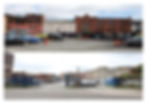
Exploring Everyday Streets
MArch 2015-16
Belfast Hopscotch - M.Arch Unit - Architecture at Queen's
‘A (pavement) life arises only when the concrete, tangible facilities it requires are present. If they are absent, public (pavement) contacts are absent too.’
Jacobs Jane, The Death and Life of Great American Cities, The Modern Library, New York 1961, 1993. p92
Streets are framed by buildings. These are the tangible facilities that allow streets to be vibrant public spaces. Belfast city centre is slowly re-encountering its identity as a lived and enjoyed area. But this livelihood can not only rely on commercial facilities or temporary events.
In October 2015 Belfast City Council will formally launch the City Centre Regeneration Strategy. Current development proposals for the city aim at large retail buildings or large student accommodation. If these are the only initiatives, some other very important types are being overlooked. The city centre still lacks buildings that would allow it to become a more complete urban area. Housing is needed in the city centre, but for this to happen, people need the desire to live there. This could be achieved by providing space for services such as education and care, especially for the youngest and the eldest in our society. This is obviously needed in the city, for the Cultural Framework of Belfast City Council states that more activities for children and young people would make the city a better place. Meanwhile it also states that Belfast has a higher percentage of older people than the Northern Ireland average.
The new devolved planning powers given to the city council may change the way people deal with the city. This has incredible potential, but we have to get involved to have some impact. As architects we have a very strong influence on the urban fabric as a whole, so every building needs to be a very careful addition to the existing built environment.
Students in MArch I and MArch II will begin the year together in a close interrogation of current so-called master plans for Belfast City Centre. Having analysed these documents, which have so much impact on the way the city is made, students will ask and answer the following questions:
Is it possible to enliven the city centre through new buildings that cater for a broader audience? Can the proposal of plot sized buildings bring more life to Belfast streets? How do we design spaces for children? How do we design spaces for the elderly? How do we deal with the threshold of public and private spaces in the city? Can people in Belfast finally own the city centre?
We will present our findings and design proposals to a variety of policy and decision makers, including the new department of Place and Planning at Belfast City Council.
link to article on Public Books/Public Streets
http://www.publicbooks.org/blog/street-space--north-street-belfast








